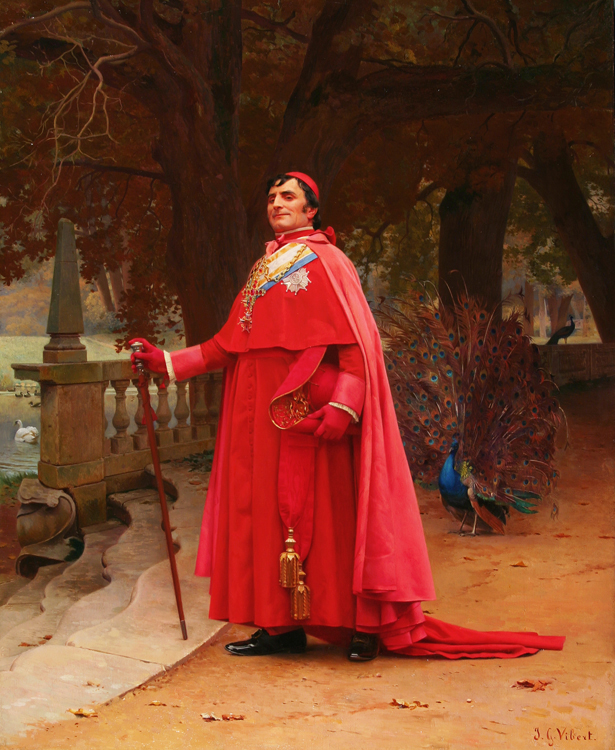In 1981, Howard Rehs, a fresh graduate of New York University with a degree in art history, joined the art gallery his father Joseph would eventually buy from the Schillay family on New York City’s Park Avenue South. Rehs spent his first year living in England, roaming the artful areas of London in search of works to add to the gallery’s inventory and learning the British Victorian market. French Nineteenth Century academic artists captured his heart and senses, however, and it is a passion he maintains today as co-owner of Rehs Galleries at 5 East 57th Street. Rehs specializes in Nineteenth and early Twentieth Century European works of art and displays paintings by many important Barbizon, realist, academic and Impressionist artists. Lately, he has been on the prowl for so-called cavalier and cardinal art. Why? we asked.
Some describe this genre as “anecdotal art.” What is your description?
I’m involved in the academic artists of the Nineteenth Century, so the cavaliers and cardinals fall well into that. Most of theses artists were academically trained, some of them were the artists that taught all the other artists, and I like the paintings … Over the years, after 2008 when everything got hit, they’re slow on the comeback, but they’re still some of the great artists of the period.
Is there a qualitative difference between art that tells a specific story, i.e., three Seventeenth Century swells enjoying a pipe and a pint in a Dutch interior versus an allegorical work that presents a grand theme?
Do you mean is it a better quality painting? Are the artists better that painted the grand theme paintings? Artists like Jean Louis Ernest Meissonier and Jean George Vibert, Francois Brunery, Jean-Leon Gerome and Charles Bargue were considered the finest academic artists of the period. The paintings that they were creating and selling were bringing some of the highest prices in that period. American collectors would come over and pay fortunes for works by these artists. In fact, one of Meissonier’s great paintings, the 1807 “Friedland,” is at the Metropolitan Museum of Art — a gift of Henry Hilton, the American businessman. They went out of favor after the Impressionists became the big thing, and in the 1920s you could buy them for pennies on the dollar. But today even a small Meissonier, 12 by 16 inches, is going to run into the hundreds of thousands of dollars. At Sotheby’s Nineteenth Century European art auction this past November, a small military scene by him brought more than $400,000.

“The Preening Peacock” by Jean-Georges Vibert (1840–1902), oil on canvas. Private collection. Courtesy Rehs Galleries, Inc.
Why do some of these artists make a lot of money and some don’t?
People don’t really understand that a lot of it has to do with when the work was painted and what the current condition of the work is. For example, there was a [Daniel] Ridgway Knight in a recent New York City auction, which when originally painted was a great painting. Now, 50 percent of it was repainted, the condition was just horrible, and it didn’t sell. So now that shows up in the records as an unsold lot and people look at it and say “Look at that, multiple figures, big painting, it didn’t sell…” so they say the others aren’t worth it, but they don’t understand that there were specific condition issues with that work and it shouldn’t have sold; the result has no bearing on a similar period work in excellent condition.
What is the cardinal subject matter all about?
I think it was the ability to make fun of the clergy. Years before that I don’t think any artist would get away with mocking the clergy, but by the mid- to late Nineteenth Century things were changing and people started to look at the clergymen who were preaching “You have to do this, you have to do that — give up all your worldly passions to God,” and so on while behind the scenes here they are sitting in gold chairs with rich fabrics, eating fabulous lunches with chefs preparing meals for them amid opulent interiors. Vibert was among the best of the artists poking fun in a gentle way. Collectors today — I have about five or six clients currently looking for cardinal paintings — most of them are “church-going” people, but these paintings really speak to them in terms of the clergy and what was happening in the Nineteenth Century. They get a kick out of seeing and collecting those kind of paintings.
Can you give us an example?
We had one called “Preening Peacock,” by Vibert, which was of a cardinal in his red cape standing there in the garden, his chest all puffed up, and right behind him is a peacock with his feathers fully unfurled. It went to a collector down South — and the family is fairly religious. —W.A. Demers


